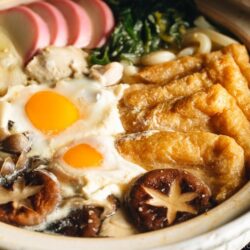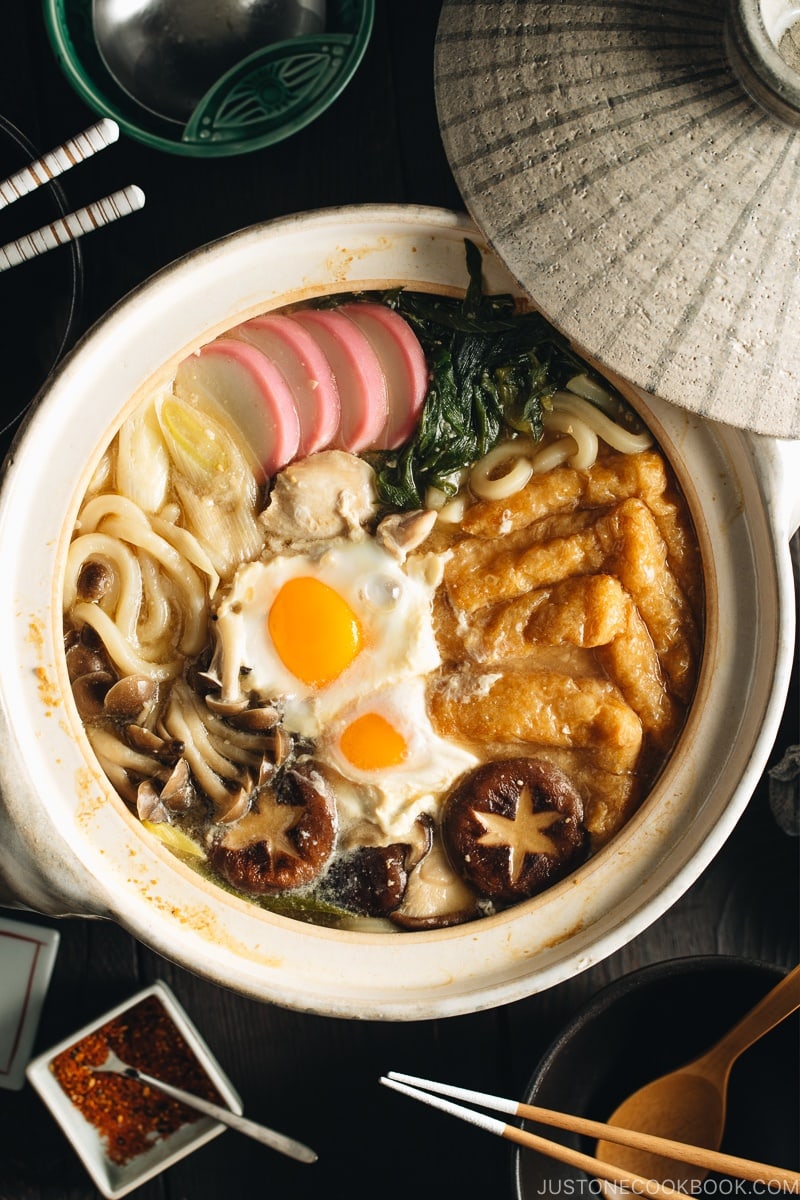
Most udon noodle soups are served in clear dashi broth seasoned with soy sauce. However, in the Nagoya region, where Hatcho miso is known, you can find delicious udon noodle soup flavored with miso, called the Miso Nikomi Udon (味噌煮込みうどん). It’s deeply savory and topped with an assortment of ingredients. Hungry? Let’s reach for the tub of miso and whatever ingredients you have in the refrigerator and make this tonight!
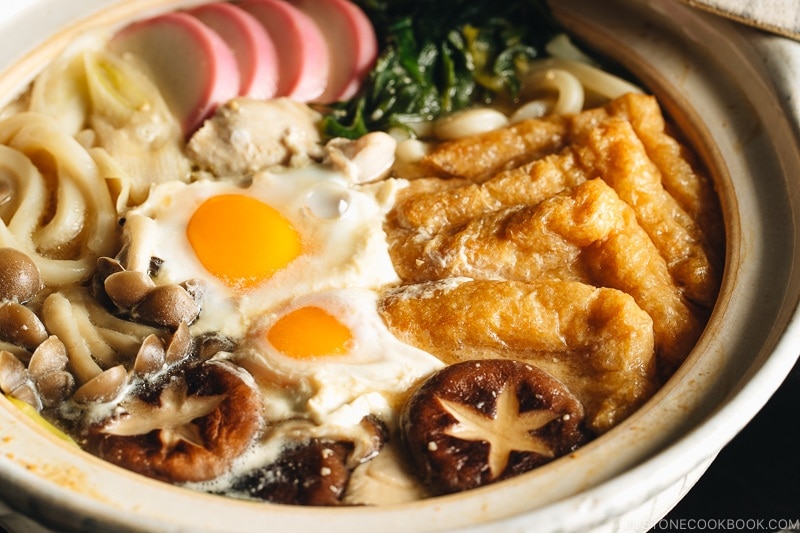
What is Miso Nikomi Udon?
A popular “regional” food in Nagoya, Miso Nikomi Udon is also widely enjoyed across the country, using different types of local miso.
The noodle soup is usually served in individual donabe (Japanese earthenware pot). When the food arrives at the table, the soup is boiling, with lots of bubbling going on, and so much steam coming off from the pot.
Inside the steamy pot, you have chewy udon noodles, chicken, egg, fish cake (kamaboko), shiitake mushroom, long green onions (Negi), and deep-fried tofu (aburaage) in a savory miso-based broth. The broth is made with dashi, usually kombu dashi, katsuo dashi, or awase dashi (the combination of the two). With the chicken being cooked inside the broth, you get some light umami-packed dashi and chicken flavor.
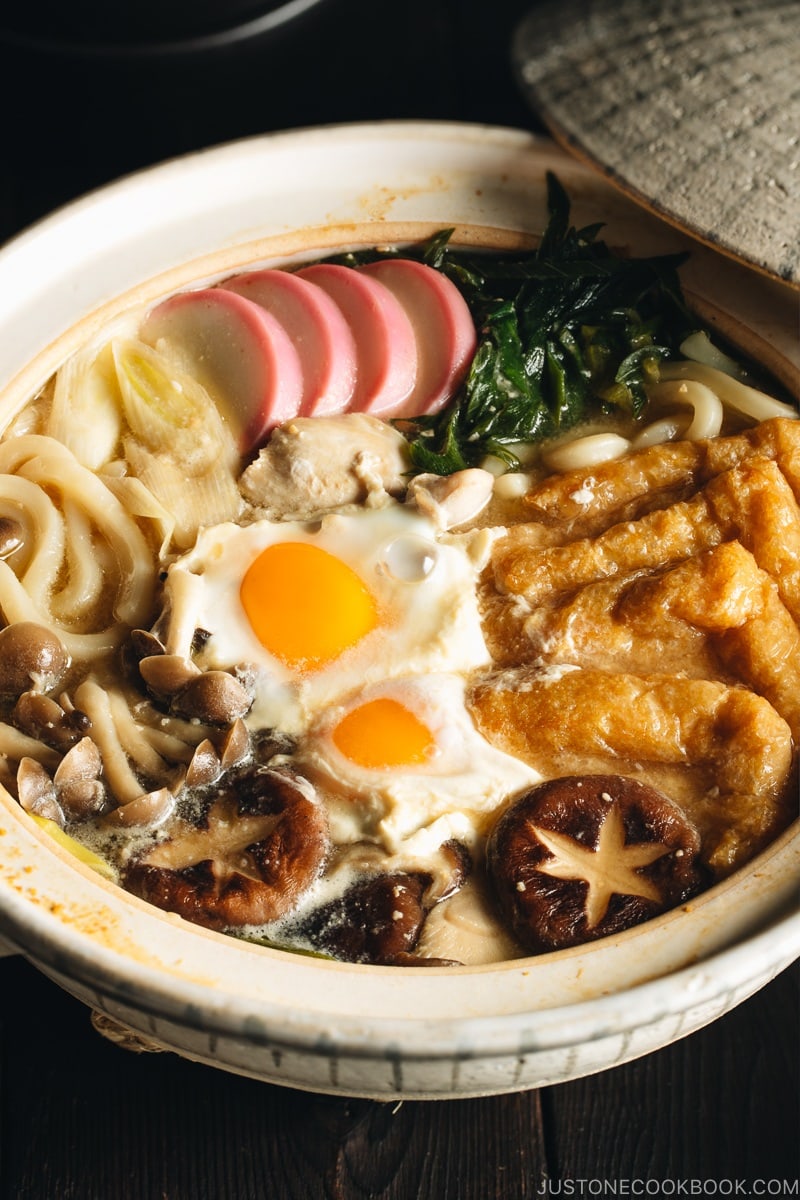
5 Ingredients for Miso Nikomi Udon & Substitutes
1. Udon noodles
The original version uses Nama Udon (生うどん), which means freshly made udon. Typically, udon noodles are made of 3 ingredients: flour, water, and salt. However, udon noodles for Miso Nikomi Udon are made of only flour and water. This reduces the salt content as miso gets salty after long-simmering.
I have a recipe for homemade udon noodles and if you have time, you should definitely make the homemade noodles first, and then make this Miso Nikomi Udon. That would be a fantastic meal!
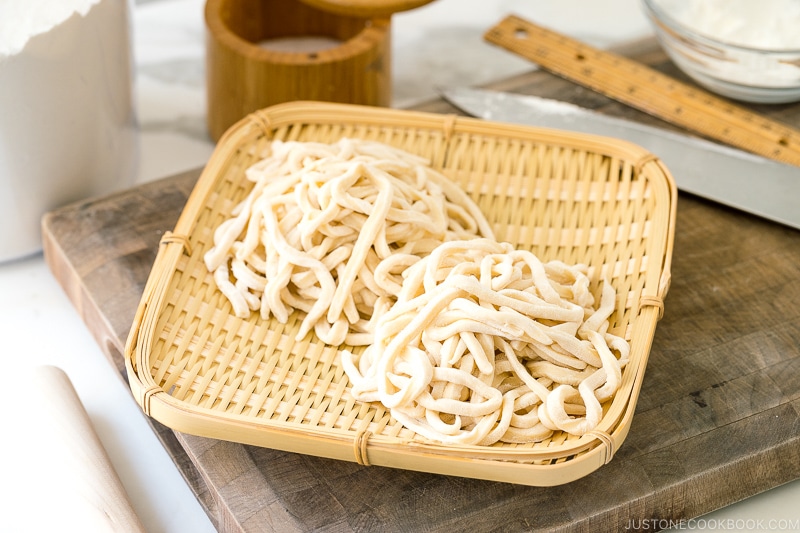
But that’s more like a weekend project. In this recipe, I use frozen precooked udon noodles from the Japanese grocery store so all you need to do is to run through hot water to separate it. I love using Sanuki-type udon for this recipe as it has a much chewier & bouncy texture. Some other udon noodles can be a bit more floury and doughy and break easily.
2. Dashi (Japanese Soup Stock)
For Miso Nikomi Udon, I recommend using Katsuo Dashi or Awase Dashi (kombu + katsuo), but it’s all up to you. You can make your favorite dashi from one of these 6 dashi options.
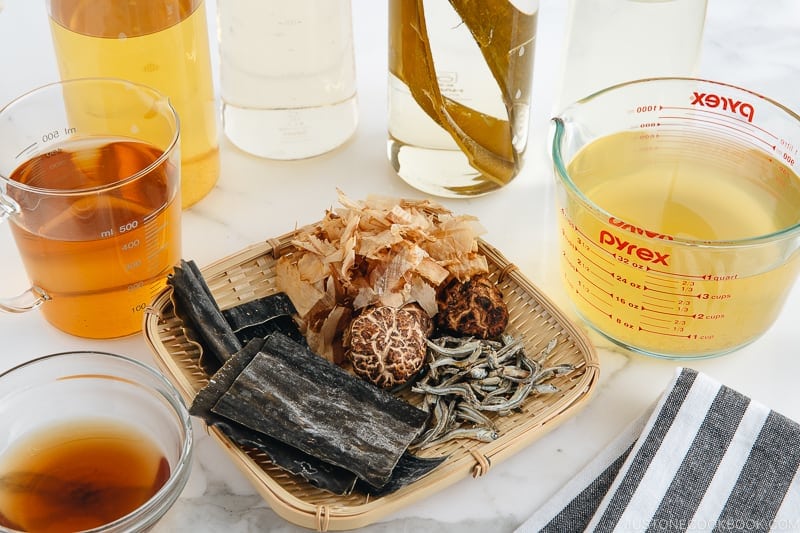
In this recipe, I made dashi using dashi packets. You can find my favorite brand of dashi packet on Amazon or your local Japanese grocery stores (I get mine from Nijiya).
For vegetarian and vegan-friendly dashi, make Vegan Dashi.
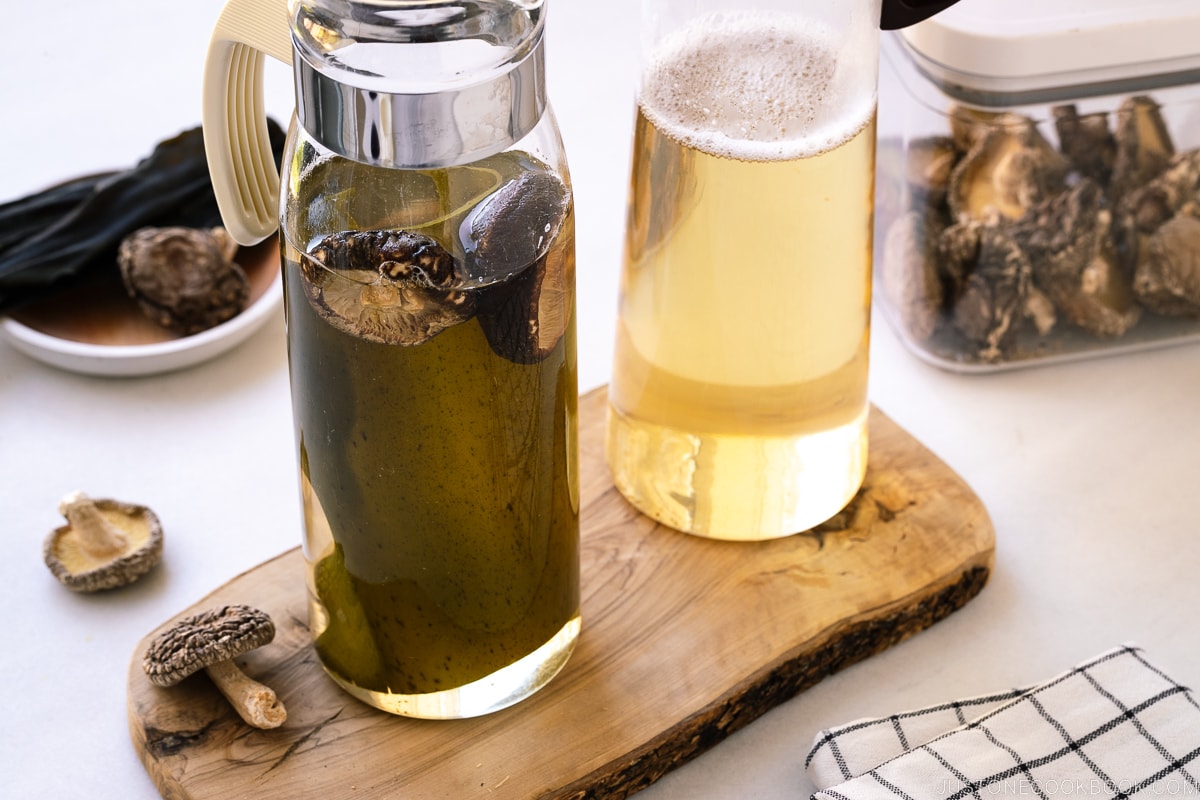
3. Your choice of the protein
Typically chicken and egg are used for this recipe, but you can omit them and make it vegetarian/vegan-friendly by adding lots of veggies, mushrooms, and tofu!
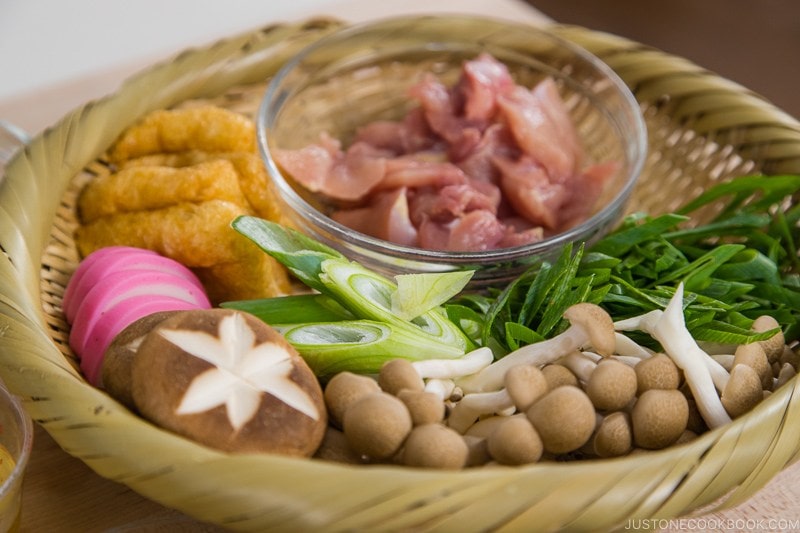
4. Other ingredients you can use
Living outside of Japan, ingredients can be hard to find. Long green onions can be replaced with the white parts of leeks and more green onions/scallions. Kamaboko, a Japanese fish cake, can be difficult to find, then try Chinese/Korean fish cakes from Asian grocery stores. Shiitake mushrooms may be hard to find, and if so, use other mushrooms available locally. To summarize, use ingredients you have in hand that you think it’ll be delicious in the miso-flavored broth.
5. Miso varieties
In the Nagoya region, Mame Miso (豆味噌), or 100% soybean miso, like Hatcho Miso (八丁味噌) is used for Miso Nikomi Udon. Mame Miso is perfect for all types of simmering dishes because it doesn’t lose much flavor and taste compared to barley miso (麦味噌) or rice miso (米味噌).
I used Hikari Miso® Organic Miso – Red Miso for my Miso Nikomi Udon, but Hikari Miso offers Hatcho Miso and we tried it for this recipe as well. Mr. JOC and I love it, but our kids don’t like the stronger taste of Hatcho Miso, so they recommended we use red miso instead.
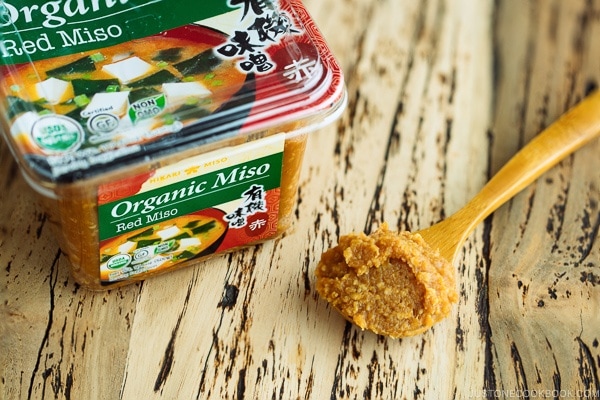
Hikari Miso’s miso is all made of 100% USDA Certified Organic rice and soybeans and is additive-free. It has a dark brown color original to Shinshu-style miso. A high volume of rice koji produces its mild taste and smooth texture.
If you’re interested to try this miso out, you can purchase Hikari Miso® organic miso from most of Japanese/Asian grocery stores or on Amazon. Hikari Miso® is my favorite brand of miso paste and I’ve been using it for over a decade.
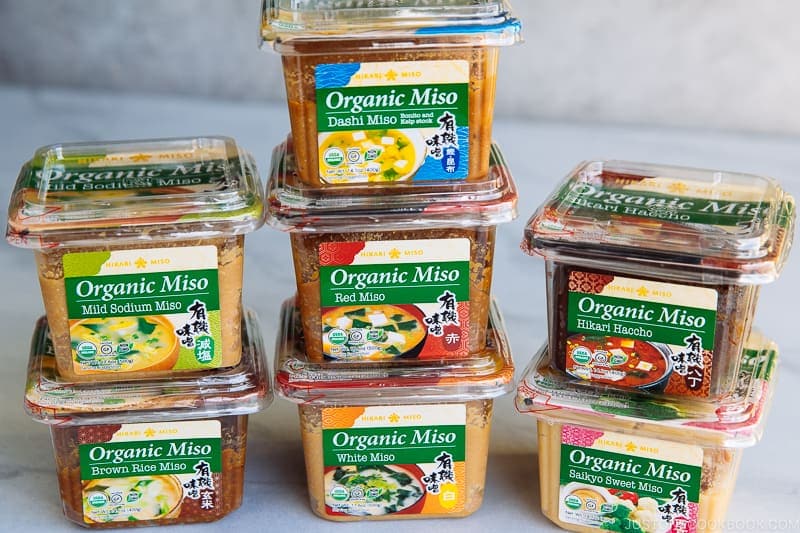
There is also a variety of miso, each with a different flavor you can use for various purposes. When you make Miso Nikomi Udon, you can choose any type of miso you like. Each miso has its own unique flavors that you can experiment with and enjoy.
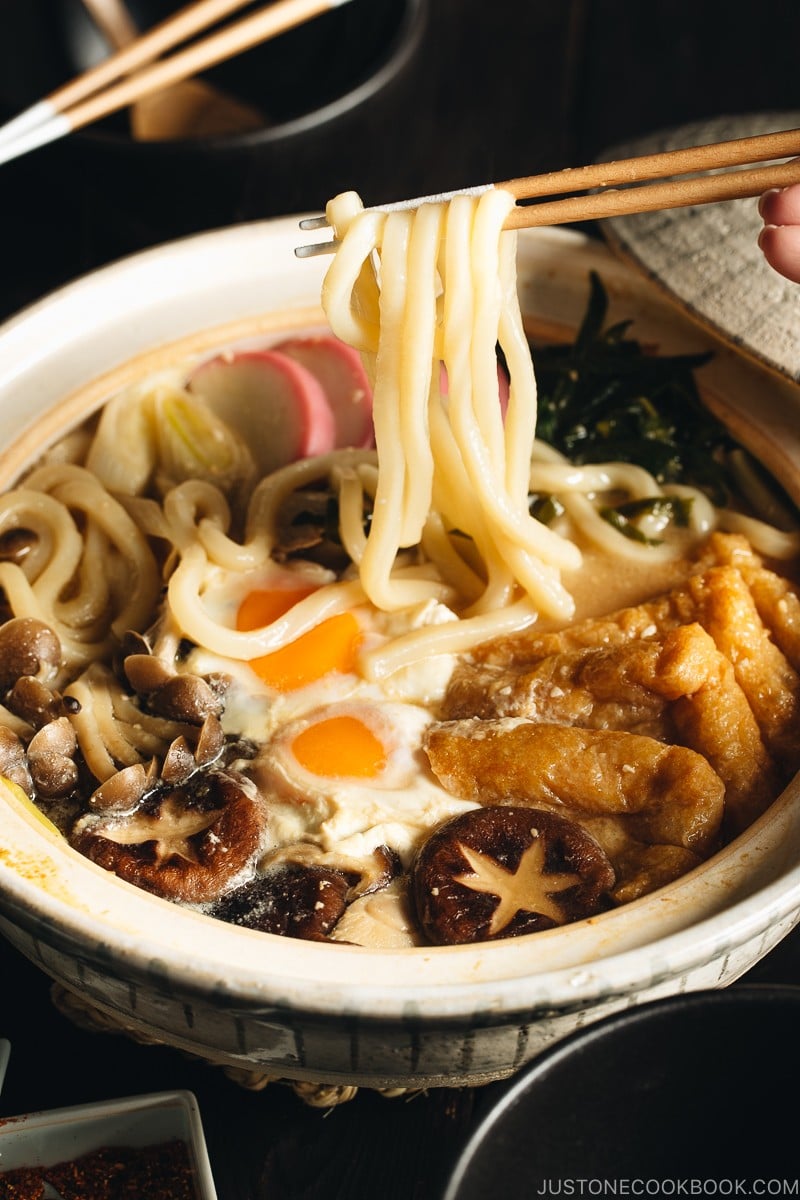
Do I need to Use a Special Japanese Pot (Donabe)?
No, you don’t have to, but if you own a donabe, this is a good excuse to take it out and make this Miso Nikomi Udon. If you haven’t used it for a while, make sure to properly season it before you start using it. Here’s my tutorial on how to season your donabe.
If you don’t own one, then just use a big pot that can fit 3 cups (720 ml) of water, udon noodles, and some ingredients for serving two people. You can use a bigger pot to double the recipe or use half a portion for one serving.
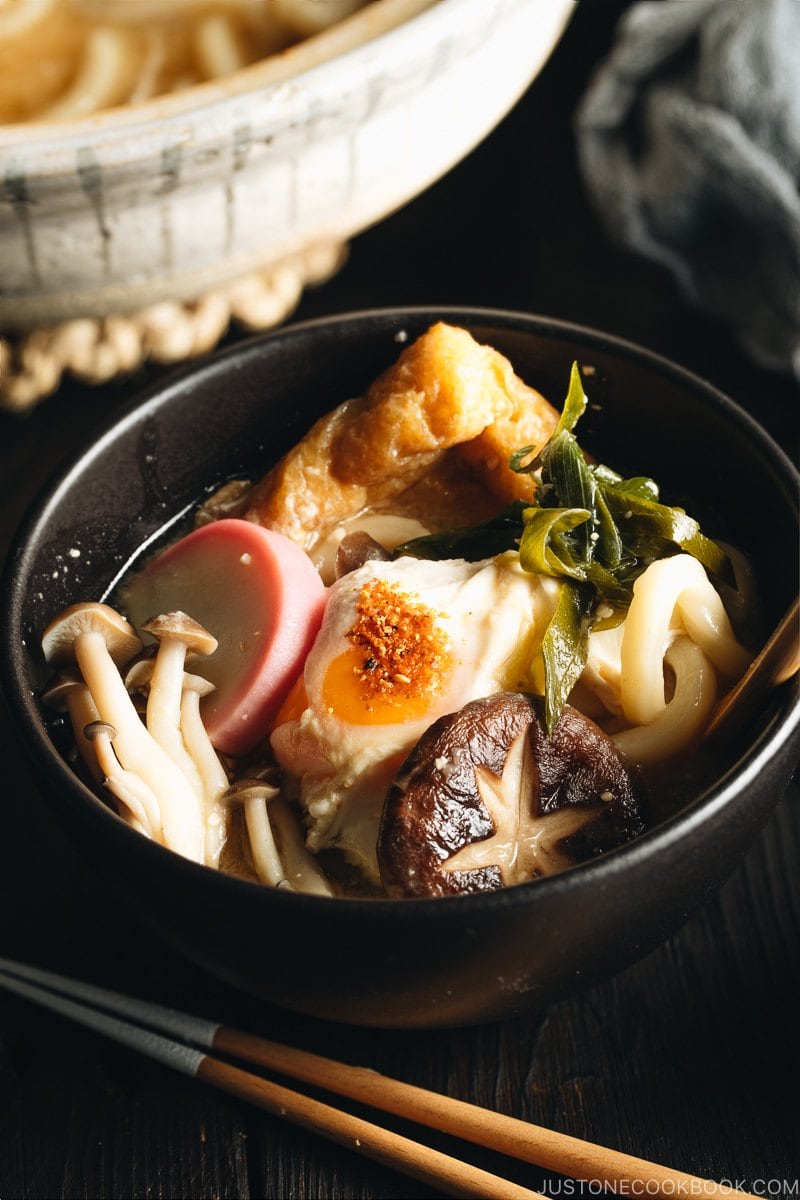
Versatile Miso Udon Noodle Soup
Miso Nikomi Udon is a very versatile noodle soup, where you can throw in any vegetables or proteins you have in the refrigerator. Here in this recipe, I used what is considered “typical” ingredients for Miso Nikomi Udon so you know how it is commonly served in Japan, but please be flexible.
To keep it “authentic”, you will still need dashi (it’s an essential ingredient for what makes Japanese food authentic) and miso for this recipe. However, noodles, vegetables, proteins, and mushrooms can be replaceable. Have fun making your own Miso Nikomi Udon!
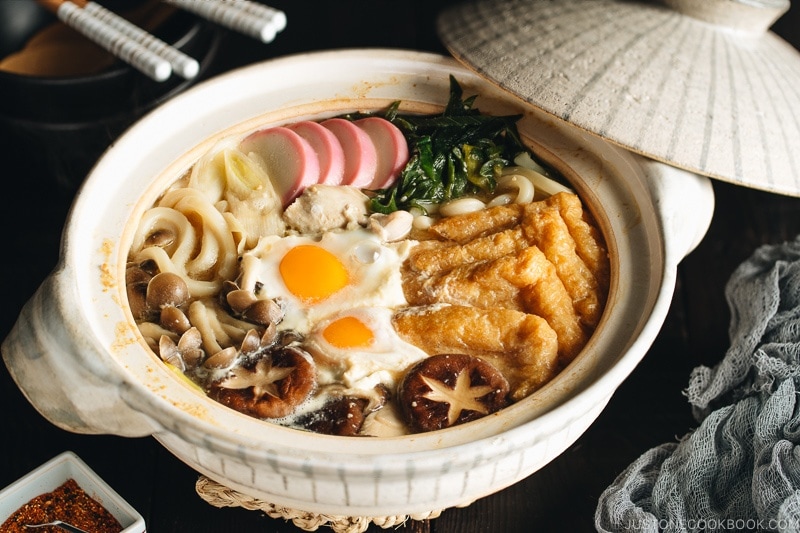
Wish to learn more about Japanese cooking? Sign up for our free newsletter to receive cooking tips & recipe updates! And stay in touch with me on Facebook, Pinterest, YouTube, and Instagram.
Miso Nikomi Udon
Ingredients
- 3 cups dashi (Japanese soup stock) (use standard Awase Dashi, dashi packet or powder, or Vegan Dashi)
- ½ package shimeji (brown beech) mushrooms (1.8 oz, 50 g)
- 4 shiitake mushrooms (2.3 oz, 65 g)
- ⅓ kamaboko (fish cake)
- 1 Tokyo negi (naga negi; long green onion) (4 oz, 113 g; or use 2 green onions)
- 1 piece aburaage (deep-fried tofu pouch) (or 2 small aburaage pieces)
- 1 chicken thigh (7 oz, 200 g)
- 2 servings udon noodles (1.1 lb, 500 g frozen or parboiled udon noodles; 6.3 oz, 180 g dry udon noodles)
- 2 large eggs (50 g each w/o shell)
- shichimi togarashi (Japanese seven spice) (for sprinkling)
Instructions
- Gather all the ingredients.
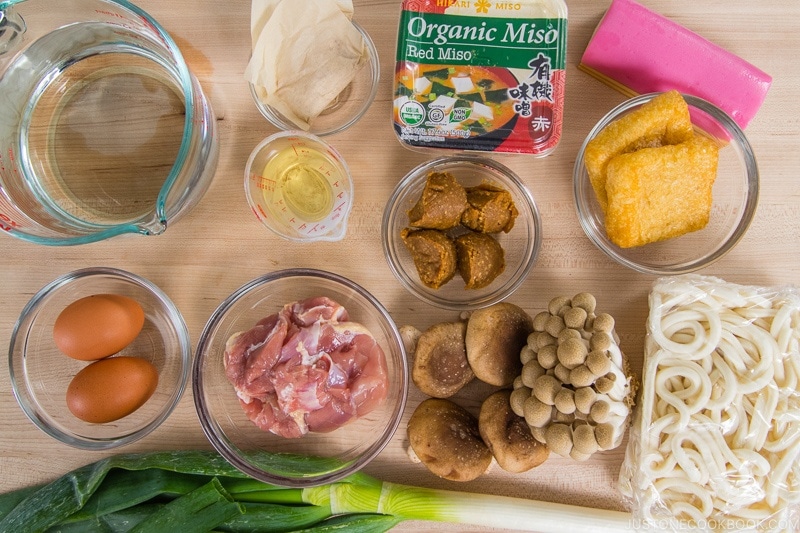
Make Dashi
- Make 3 cups dashi (Japanese soup stock) using one of 3 Ways to Make Dashi. Here, I used the convenient dashi packet method. If you want to make dashi from scratch, follow my Awase Dashi recipe. If you’re vegetarian/vegan, use Vegan Dashi.

To Prepare the Ingredients
- Cut the ends of ½ package shimeji (brown beech) mushrooms and separate into smaller clusters.
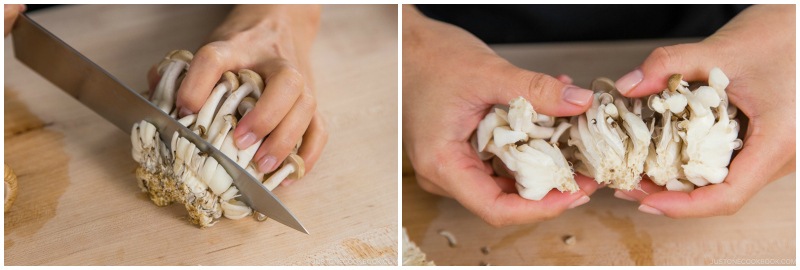
- Cut the stems of 4 shiitake mushrooms. Cut the caps in half. I use the sogigiri Japanese cutting technique to increase the surface area.
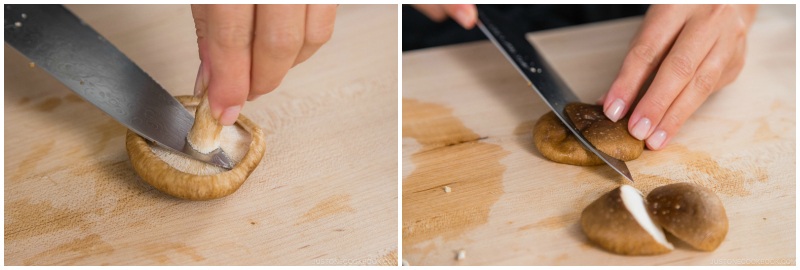
- If you‘d like, you can make a decorative cut called hanagiri on the shiitake caps.
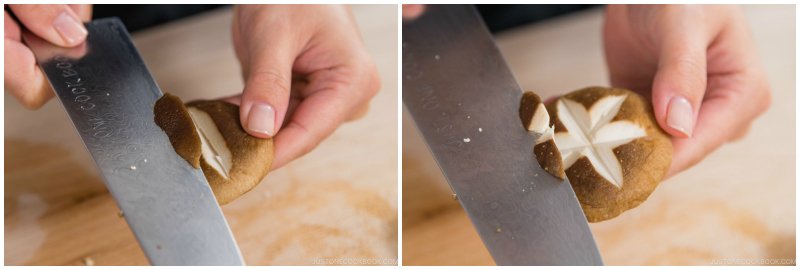
- Cut ⅓ kamaboko (fish cake) into 4 slices.
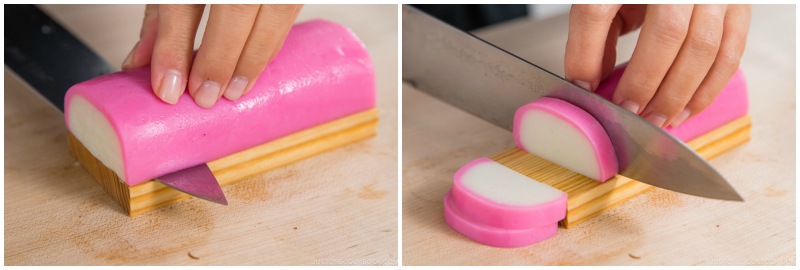
- Cut 1 Tokyo negi (naga negi; long green onion) diagonally, and separate the white and green parts (we will add them to the pot at different times).
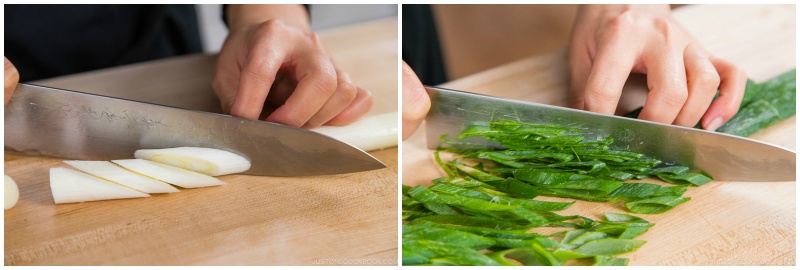
- Pour hot water over 1 piece aburaage (deep-fried tofu pouch) to get rid of the factory oil. Some people skip this step as the oil used is cleaner these days. I do it anyway to get rid of excess oil. Optionally, you can cut it into smaller pieces like triangles.
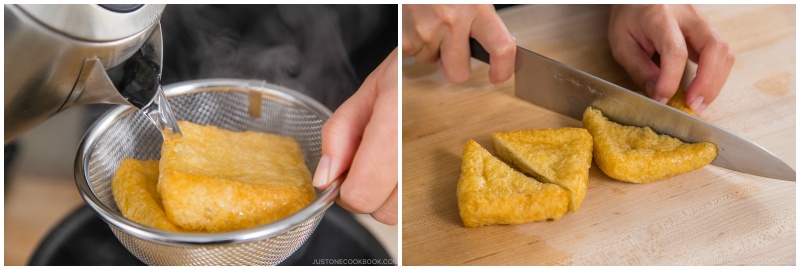
- Cut 1 chicken thigh into smaller bite-size pieces. I use the sogigiri technique to create a bigger surface area on the chicken so it will cook faster and absorb more flavors.
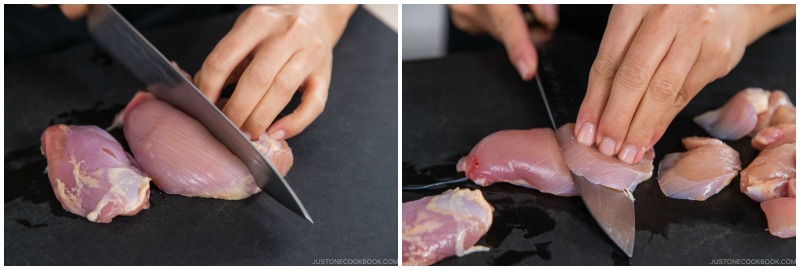
- Bring a pot of water to a boil. Add 2 servings udon noodles (frozen or parboiled) and loosen them with chopsticks. Once loosened (30 seconds or so), drain the udon noodles into a colander and set aside. If you use dry noodles, follow the package instructions.
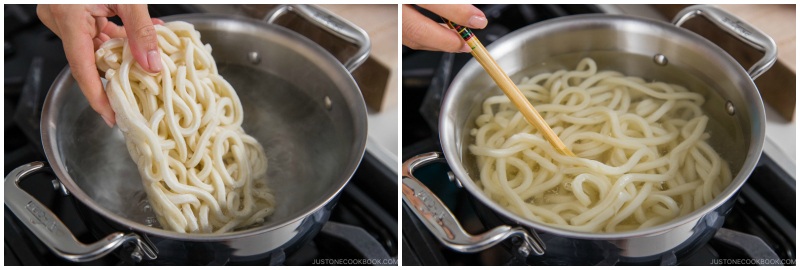
- Crack 2 large eggs (50 g each w/o shell) into a small bowl (so you won’t accidentally drop an eggshell into the pot). All the ingredients are now ready to go!
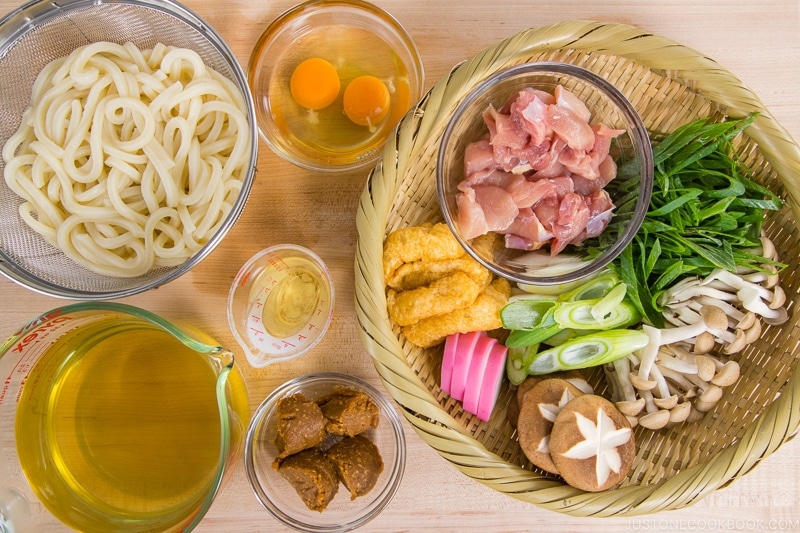
To Cook the Miso Nikomi Udon
- In a large pot or donabe, add the dashi, chicken, and white part of the negi.
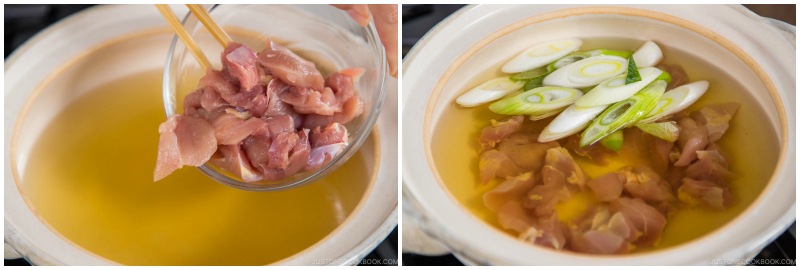
- Cover to cook on medium heat for 10 minutes, or until the outside of the chicken is no longer pink (the inside can be still pink at this stage). When it boils, turn the heat down to maintain a simmer. Skim off the fat and scum with a fine-mesh skimmer.
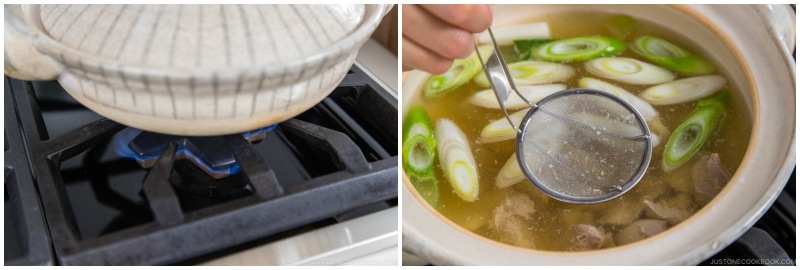
- Add 3 Tbsp mirin and 3 Tbsp miso. (Keep the remaining 1 Tbsp for later. Why? Read my post.) I use a miso muddler that works wonderfully to dissolve the miso completely. You also can place the miso in a ladle with some hot dashi and use cooking chopsticks to dissolve the miso before releasing it to the soup. This ensures that there are no miso chunks left at the bottom of the pot.
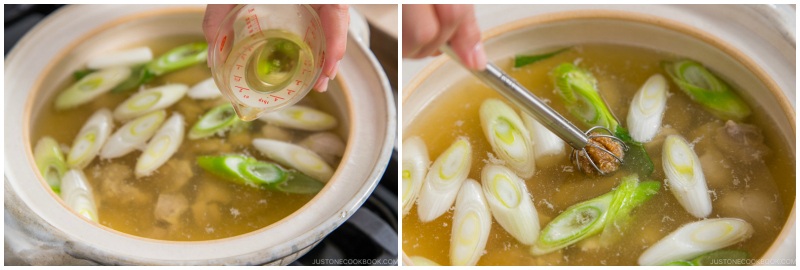
- Add the udon noodles, aburaage, shimeji mushrooms, shiitake mushrooms, and green part of the negi. If you care about the presentation of this dish, now is a good time to fish out the chicken and vegeteables and place each ingredient neatly on top of the noodles.
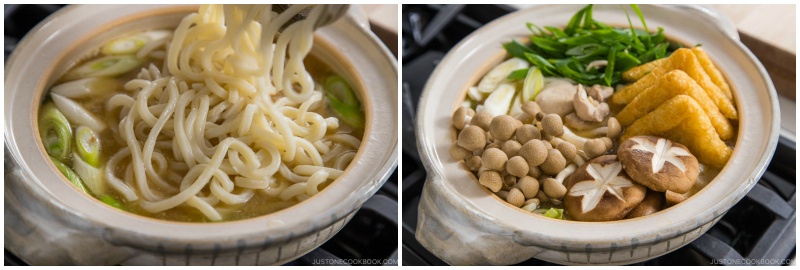
- Increase the heat to medium, cover with the lid, and cook for 5 minutes. Once boiling, turn the heat down to a simmer. Once in a while, check with your cooking chopsticks that the udon or other ingredients are not stucking to the bottom of the pot. Skim off the fat and scum with a fine-mesh skimmer.
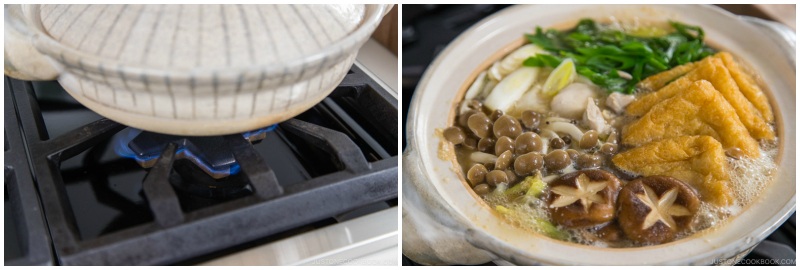
- Add the remaining 1 Tbsp miso to the soup. Be careful not to drop in a whole chunk of miso. Use a ladle as a “mixing bowl” to first dissolve the miso in some dashi before adding it to the soup.
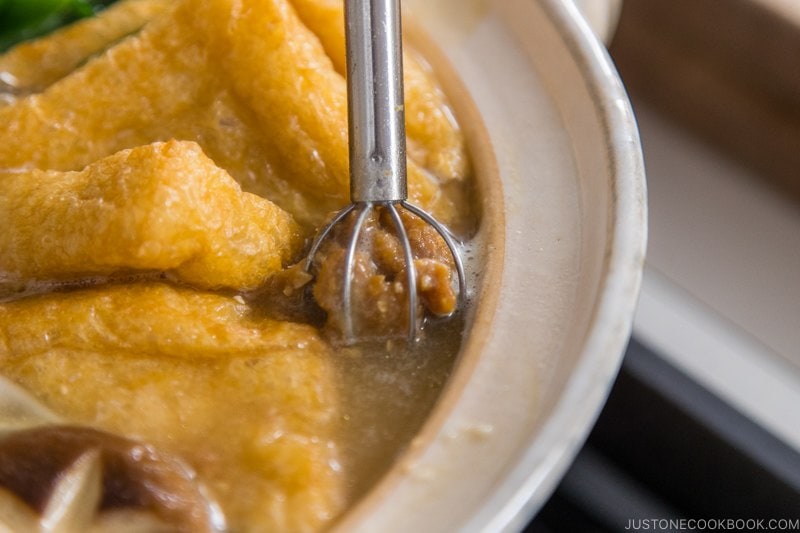
- Add the kamaboko fish cakes (where you can display its nice color) and carefully drop the eggs in the middle. From this point, you do not want to cover with the lid (since egg yolk will develop a thin white coating if you cover it). Cook for 2–3 minutes.
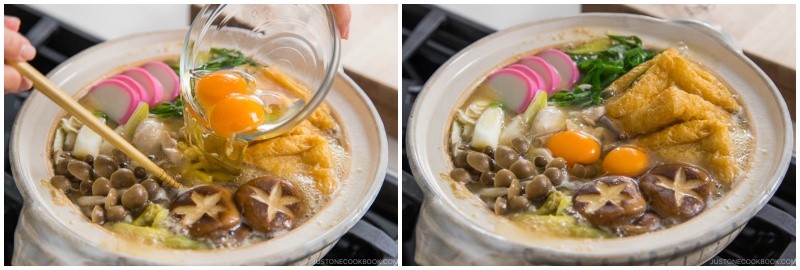
To Serve
- Serve the pot at the table. Portion into the individual bowls and sprinkle shichimi togarashi (Japanese seven spice) for a spicy kick.
To Store
- Keep the soup broth and toppings separately in airtight containers and store in the refrigerator for up to 3 days. It‘s best to prepare the udon noodles right before you assemble and serve.
Nutrition
Did you make this recipe?
Tag @justonecookbook on Instagram so we can see your delicious creation!


